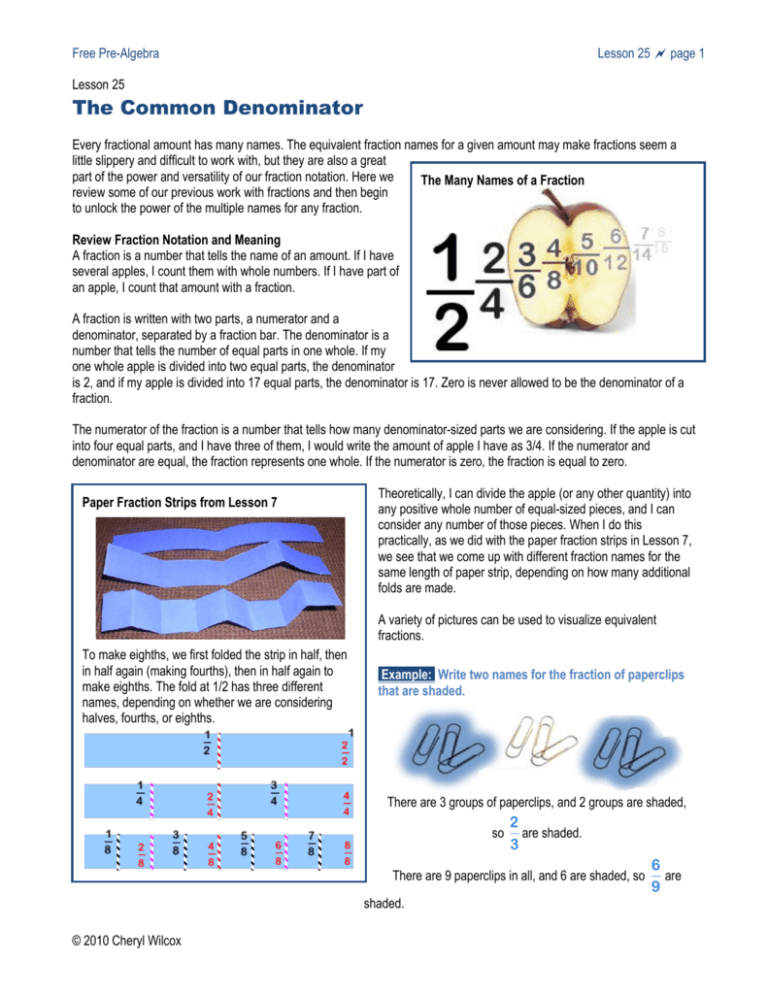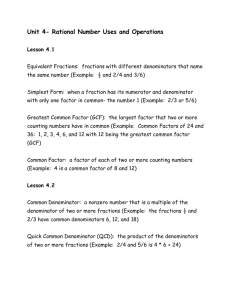Lesson 25: The Common Denominator
advertisement

Free Pre-Algebra Lesson 25 page 1 Lesson 25 The Common Denominator Every fractional amount has many names. The equivalent fraction names for a given amount may make fractions seem a little slippery and difficult to work with, but they are also a great part of the power and versatility of our fraction notation. Here we The Many Names of a Fraction review some of our previous work with fractions and then begin to unlock the power of the multiple names for any fraction. Review Fraction Notation and Meaning A fraction is a number that tells the name of an amount. If I have several apples, I count them with whole numbers. If I have part of an apple, I count that amount with a fraction. A fraction is written with two parts, a numerator and a denominator, separated by a fraction bar. The denominator is a number that tells the number of equal parts in one whole. If my one whole apple is divided into two equal parts, the denominator is 2, and if my apple is divided into 17 equal parts, the denominator is 17. Zero is never allowed to be the denominator of a fraction. The numerator of the fraction is a number that tells how many denominator-sized parts we are considering. If the apple is cut into four equal parts, and I have three of them, I would write the amount of apple I have as 3/4. If the numerator and denominator are equal, the fraction represents one whole. If the numerator is zero, the fraction is equal to zero. Paper Fraction Strips from Lesson 7 Theoretically, I can divide the apple (or any other quantity) into any positive whole number of equal-sized pieces, and I can consider any number of those pieces. When I do this practically, as we did with the paper fraction strips in Lesson 7, we see that we come up with different fraction names for the same length of paper strip, depending on how many additional folds are made. A variety of pictures can be used to visualize equivalent fractions. To make eighths, we first folded the strip in half, then in half again (making fourths), then in half again to make eighths. The fold at 1/2 has three different names, depending on whether we are considering halves, fourths, or eighths. Example: Write two names for the fraction of paperclips that are shaded. There are 3 groups of paperclips, and 2 groups are shaded, so 2 are shaded. 3 There are 9 paperclips in all, and 6 are shaded, so shaded. © 2010 Cheryl Wilcox 6 are 9 Free Pre-Algebra Lesson 25 page 2 Example: Use the rectangle to show that 2/3 is equivalent to 8/12. The rectangle is divided along the length into three parts. Two parts are shaded, so 2/3 of the rectangle is shaded. To show that 2/3 is equivalent to 8/12, we show that when the rectangle has 12 equal parts, the shading will cover 8. We want to divide the rectangle into 12 equal parts. We have 3 parts, and 12 = 3 • 4, so each of the three parts should be divided into 4 more parts. The easiest way to do this is to cut the rectangle into fourths along the width. When you count the shaded parts, you see that 8 of the 12 parts are shaded. So 2/3 and 8/12 are different ways to name the same shaded amount and so are equivalent fractions. 2 3 8 12 Look, Ma, No Pictures We can find different names for the same fraction amount by multiplying or dividing the numerator and denominator of the fraction by the same number. 1 2 1 4 2 4 4 8 8 16 8 8 16 8 1 2 When there is no common factor in the numerator and denominator that we can divide out, the fraction is in lowest terms. Usually the lowest terms name for a fraction is preferred. However, there are times in our work with fractions when it is necessary or at least much more convenient to use a higher terms name temporarily. The Common Denominator If we compare lengths with the ruler, we can see that a line measuring 7/8 inch is longer than a line measuring 13/16 inch. If we want to compare those lengths by just looking at the fraction names, that’s tougher. It’s not obvious just from looking at the numbers that 7/8 > 13/16. But if you write both fraction names as 16ths, it becomes much clearer. 7/8 is the same as 14/16, and since 14 is more 16ths than 13, 14/16 > 13/16 is an easy comparison. Writing both fractions with the same denominator lets us compare the amounts far more easily. To add lengths using the ruler, we just need to place them side by side and read off the total length. In the picture the blue line is 13/16 inch, and the red line is 7/8 inch. The total length of both lines is 111/16 inches. But suppose you want to add the lengths without drawing and measuring. It’s not clear how to do that with the fractions expressed in lowest terms. But if we temporarily write 7/8 as 14/ , the denominator of 16 shared by both fractions lets us add the parts 16 easily. We are adding 13 of the sixteenths to 14 of the sixteenths, so the answer is 27 of the sixteenths. The fraction 27/16 is equal to the mixed number 111/16. If the fractions have the same denominator, adding them just requires adding the numerators. On the inch ruler, we can always use sixteenths, since every other fractional length on the ruler can be written as sixteenths. When working with arbitrary fractions in different circumstances, we need to find a way to express all the fractions involved with the same denominator so that they can be compared or added. © 2010 Cheryl Wilcox Free Pre-Algebra Lesson 25 page 3 Example: Write the fraction name for the shaded part of each rectangle. Then divide each rectangle into 12ths to find equivalent fraction names for the shaded parts of each. The rectangle has 3 parts. To make 12 parts, divide the width into fourths. 1 part is shaded. 4/12 is shaded. 1/3 is shaded. The rectangle has 4 parts. To make 12 parts, divide the length into thirds. 3 parts are shaded. 9/12 is shaded. 3/4 are shaded. Why were we able to make the two rectangles have the same size pieces? The denominators 3 and 4 multiply to make 12. The arrangements of the rectangles helped suggest how to divide the rectangles so the parts looked identical. To write what we did with the rectangles in mathematical notation: 1 3 1 4 3 4 4 12 3 4 3 3 4 3 9 12 It’s so convenient to have 1/3 and 3/4 both written in twelths. Since both rectangles have the same size pieces, adding or comparing the pieces becomes straightforward and simple. Once I know that 9 12 3 4 1 3 4 3 and 12 4 9 , 12 4 12 1 3 9 4 12 12 3 1 4 3 13 12 13 12 9 4 12 12 3 1 4 3 5 12 5 12 The two original fractions had denominators of 3 and 4. The new equivalent fraction names have denominators of 12, the product of 3 and 4. No matter what your original two denominators, multiplying one by the other will always result in a common denominator for both fractions. Example: Build five fractions equivalent to each of the given fractions. 1 4 2 8 3 12 4 16 5 20 6 24 5 6 10 12 15 18 20 24 25 30 30 36 Now look through the list of equivalent fractions and find denominators that appear on both lists. There are two denominators common to both lists, 12 and 24. 1 4 2 8 3 12 4 16 5 20 6 24 5 6 10 12 15 18 20 24 25 30 30 36 If I need to add or compare the fractions 1/4 and 5/6, I could use a common denominator of 12 or 24. To keep the numbers as small as possible we use the first denominator common to both lists, called the lowest common denominator. © 2010 Cheryl Wilcox Free Pre-Algebra Lesson 25 page 4 Finding the Lowest Common Denominator More Efficiently It seems a little wasteful to generate long lists of equivalent fractions that we then search for the common denominator. Most people use some informal mental steps to shorten the process. Example: Find equivalent fractions for 3/10 and 6/25 that have a common denominator. The common denominator has to appear on both lists of equivalent fractions, so it is a multiple of both 10 and 25, the original denominators. If I generate fractions equivalent to 6/25 (larger denominator) until I have a denominator that is a multiple of 10, I will have found the common denominator. I begin generating equivalent fractions: 6 25 12 50 The first equivalent fraction, generated by multiplying numerator and denominator of 6/25 by 2, has a denominator of 50, which is divisible by 10. Now I need to find a fraction equivalent to 3/10 with denominator 50. 3 10 ? 50 Since I would have to multiply 10 by 5 to get 50, I multiply both numerator and denominator by 5. 3 10 3 5 10 5 15 50 Now I have written equivalent fractions with a denominator of 50 for both fractions and can compare, add, or subtract them. Common Denominators from the Prime Factorization The mental steps above or some similar process can become automatic and nearly subconscious if you are very familiar with your times tables. But there’s an alternate method that automatically creates the two equivalent fractions you are looking for. It uses the prime factorizations of the two denominators. Example: Find equivalent fractions for 3/10 and 6/25 that have a common denominator. Step 1 Write the prime factorization of each denominator. Leave the numerators alone. Step 2 We want both denominators to have the exact same factors. We cannot remove factors, but we can multiply by new factors, so long as we multiply both numerator and denominator by the same number. Step 3 Both denominators now have the factors 2 • 5 • 5. Multiply to find the new fractions with a common denominator. 10 has a factor of 2, but 25 doesn’t. Multiply by 2/2. 6 25 6 5•5 6 25 6 2 • 5•5 2 6 25 6 2 • 5•5 2 12 50 3 10 3 5 • 2•5 5 15 50 25 has two 5s, but 10 only has one 5. Multiply by 5/5. 3 10 3 2•5 © 2010 Cheryl Wilcox 3 10 3 5 • 2•5 5 Free Pre-Algebra Lesson 25 page 5 If there are more than two fractions, you can still use the prime factorization method. Just be sure every factor of every denominator is present. Example: Find equivalent fractions for 1/6, 1/4, and 1/8 that have a common denominator. Step 1 Step 2 Step 3 1 4 1 2•2 1 4 1 2 3 • • 2•2 2 3 1 8 1 2•2•2 1 8 1 3 • 2•2•2 3 1 6 1 2•3 1 6 1 2•2 • 2•3 2•2 1 4 1 2 3 • • 2•2 2 3 6 24 1 8 1 3 • 2•2•2 3 3 24 1 6 1 2•2 • 2•3 2•2 4 24 Using the prime factorization method is especially helpful when the fractions include variables in the denominator. Example: Find equivalent fractions for 5/6a2 and 5/4a that have a common denominator. Step 1 5 6a 2 5 4a Step 2 Step 3 5 2•3•a •a 5 6a 2 5 2 • 2•3•a •a 2 5 2•2•a 5 4a 5 3•a • 2•2•a 3•a 5 6a 2 5 4a 5 2 • 2•3•a •a 2 5 3•a • 2•2•a 3•a 10 12a 2 15a 12a 2 When you complete the process of finding a common denominator, the fractions are not in lowest terms. Resist the temptation to simplify! You temporarily want this higher term version of the fraction names so that the fractions can be compared or added. © 2010 Cheryl Wilcox Free Pre-Algebra Lesson 25 page 6 Lesson 25: The Common Denominator Worksheet Name _______________________________________ 1. Write the fraction names for the shaded part of each rectangle. Then divide both rectangles into 15ths to find equivalent fractions with a denominator of 15. 2. List six equivalent fractions for each fraction. Circle the denominators common to both lists. 3 14 4 21 Which fraction represents a greater amount, 3/14 or 4/21? 3. The denominators have been factored and missing factors 4. Fill in the missing factors for each fraction to make a supplied. Multiply to find representations with a common common denominator. Multiply to make equivalent fractions. denominator. What is the common denominator? 90 3 14 3 3 • 2•7 3 4 21 4 2 • 3•7 2 7 18 7 2•3•3 8 15 8 3•5 5. Find equivalent fractions with a common denominator for each pair of fractions. 3 4 3 4 3 4 11 16 1 6 8 9 2 35 2 35 2 35 4 5 4 15 4 9 © 2010 Cheryl Wilcox Free Pre-Algebra Lesson 25 page 7 Lesson 25: The Common Denominator Homework 25A Name _________________________________________ 1. Compare the expressions with >, <, or =. 2. Simplify (operations with integers). a. 8 4 a. 2 7 b. 1 1 2 b. 7 7 1 c. 2 c. 7 ( 7) 1 2 d. 7( 7) 1 2 d. 1 e. 7 / ( 7) e. 1 6 1 6 f. (7)( 7)( 2) f. 6 6 1 g. 7 ( 7)( 2) ( 5)2 h. 7 ( 7)(2) 1 g. 52 3. Simplify (algebraic expressions). 4. Solve (equations with integers). a. 5x 6x a. 7x 8 1 b. 5x 6x b. 2 x 18 c. 4 3 x 5 c. 5(x 6) d. 5(x 6) 5(x 6) e. 5x 2y 6y 2x f. 6( x g. 6 4x 9) 8 6 5x © 2010 Cheryl Wilcox Free Pre-Algebra Lesson 25 page 8 5. Simplify. 6. Inch ruler. a. Measure the lines. a. 112 72 b. 63ab 72b b. Find the total length. 1 c. 3 • 72 d. 24 5 • 25 72 e. Change 13 5 to an improper fraction. 8 7. Divide the rectangles so they have the same number and size parts. Write equivalent fractions for the shaded areas with a common denominator. c. 3/4 inch is the same as 6/8 inch. Add 5/8 and 6/8, then compare the sum to the total length. 8. Find equivalent fractions with a common denominator. a. 4 9 2 5 b. 5 6 4 9 1 2 If you combine the shaded areas, how much total area will be shaded? 2 3 c. 2 5 4 9 © 2010 Cheryl Wilcox Free Pre-Algebra Lesson 25 page 9 Lesson 25: The Common Denominator Homework 25A Answers 1. Compare the expressions with >, <, or =. 2. Simplify (operations with integers). a. 8 < 4 a. 2 7 b. 1 < 1 2 b. 7 7 0 7 7 c. 7 ( 7) 1 1 c. = 2 2 1 e. 7 / ( 7) f. (7)( 7)( 2) e. 1 6 > 1 6 5 f. 6 5 5 g. 7 ( 7)( 2) 25 25 h. 7 ( 7)(2) 1 = 6 1 g. 52 < ( 5)2 5 14 49 d. 7( 7) 1 2 d. 1 > 5 98 7 14 7 7 ( 14) 7 14 21 3. Simplify (algebraic expressions). 4. Solve (equations with integers). a. 5x 6x 11x a. 7x b. 5x 6x 1x c. 5(x 6) 5x x d. 5(x 6) 5(x 6) e. 5x 2y 6y 2x g. 6 4x 9) 8 6 5x © 2010 Cheryl Wilcox 1 7x 8 7x 1 7 x 1 30 b. 2 f. 6( x 8 6x 5x 30 5x 30 0x 60 60 3x 6 6 4x 0 1x x 46 5x 18 x 2 18 x 20 x 20 4y 54 8 6x x c. 4 7x 8 8 1 8 7x / 7 7 / 7 x 2 2 18 2 3 x 5 x 3 5 4 x 3 20 x 17 x 3 5 •5 4•5 x 3 3 20 3 Free Pre-Algebra Lesson 25 page 10 5. Simplify. 112 a. 72 b. 6. Inch ruler. 2 • 2 • 2 •2•7 2 • 2 • 2 •3•3 63ab 72b c. 3 • 1 72 3 • 3 •7•a • b 2•2•2• 3 • 3 • b 3 1 • 1 72 a. Measure the lines. 14 9 7a 8 Blue line is 5/8 inch. Red line is 3/4 inch. b. Find the total length. 1 24 24 d. 24 5 • 25 72 24 • 25 5 72 5 1 15 The total length is 1 and 3/8 inches. 3 5 e. Change 13 to an improper fraction. 8 5 104 5 109 13 8 8 8 9 c. 3/4 inch is the same as 6/8 inch. Add 5/8 and 6/8, then compare the sum to the total length. 7. Divide the rectangles so they have the same number and size parts. Write equivalent fractions for the shaded areas with a common denominator. 8. Find equivalent fractions with a common denominator. 2 5 5 8 a. 4 10 b. 1 2 5 10 If you combine the shaded areas, how much total area will be shaded? 5 10 © 2010 Cheryl Wilcox 4 10 9 10 c. 6 8 2 3 2 3 • 3 3 6 9 4 9 4 3•3 4 9 5 6 5 3 • 2•3 3 15 18 4 9 4 2 • 3•3 2 8 18 2 5 2 3•3 • 5 3•3 18 45 4 9 4 5 • 3•3 5 20 45 11 3 1 8 8 Free Pre-Algebra Lesson 25 page 11 Lesson 25: The Common Denominator Homework 25B Name __________________________________________ 1. Compare the expressions with >, <, or =. 2. Simplify (operations with integers). a. 9 a. 9 ( 10) b. 9 c. 1 2 d. 1 2 e. 10 10 10 b. 9 ( 10) 1 2 c. 9 10 d. 9( 10) 1 2 9 e. 10 9 9 10 f. ( 2)3 23 g. 9 ( 9) f. 10 / ( 10) g. ( 9)( 10)( 1) 9 9 h. 102 3. Simplify (algebraic expressions). 4. Solve (equations with integers). a. 9a 10a a. 4x b. 9a 10a 7 35 c. (9a)( 10a) b. 1 x d. 9 10a 5a 2 e. 9(a 10) f. 9(a 10) 10(a 9) g. 9a 4b 6b 9a © 2010 Cheryl Wilcox c. x 2 2 5 Free Pre-Algebra 5. Simplify. Lesson 25 page 12 6. Inch ruler. a. Measure the lines. a. 195 273 b. 24xyz 26wxy c. 45 • 16 8 b. Find the total length. 1 2 d. (2 )(4) e. Change 45 to an improper fraction. 8 7. Divide the rectangles so they have the same number and size parts. Write equivalent fractions for the shaded areas with a common denominator. c. 1/4 inch is the same as 4/16 inch. Add 1 4/16 and 7/16, then compare the sum to the total length. 8. Find equivalent fractions with a common denominator. a. 1 2 3 7 b. 5 6 2 9 1 3 If you combine the shaded areas, how much total area will be shaded? 5 6 c. 5 6 2 7 © 2010 Cheryl Wilcox







